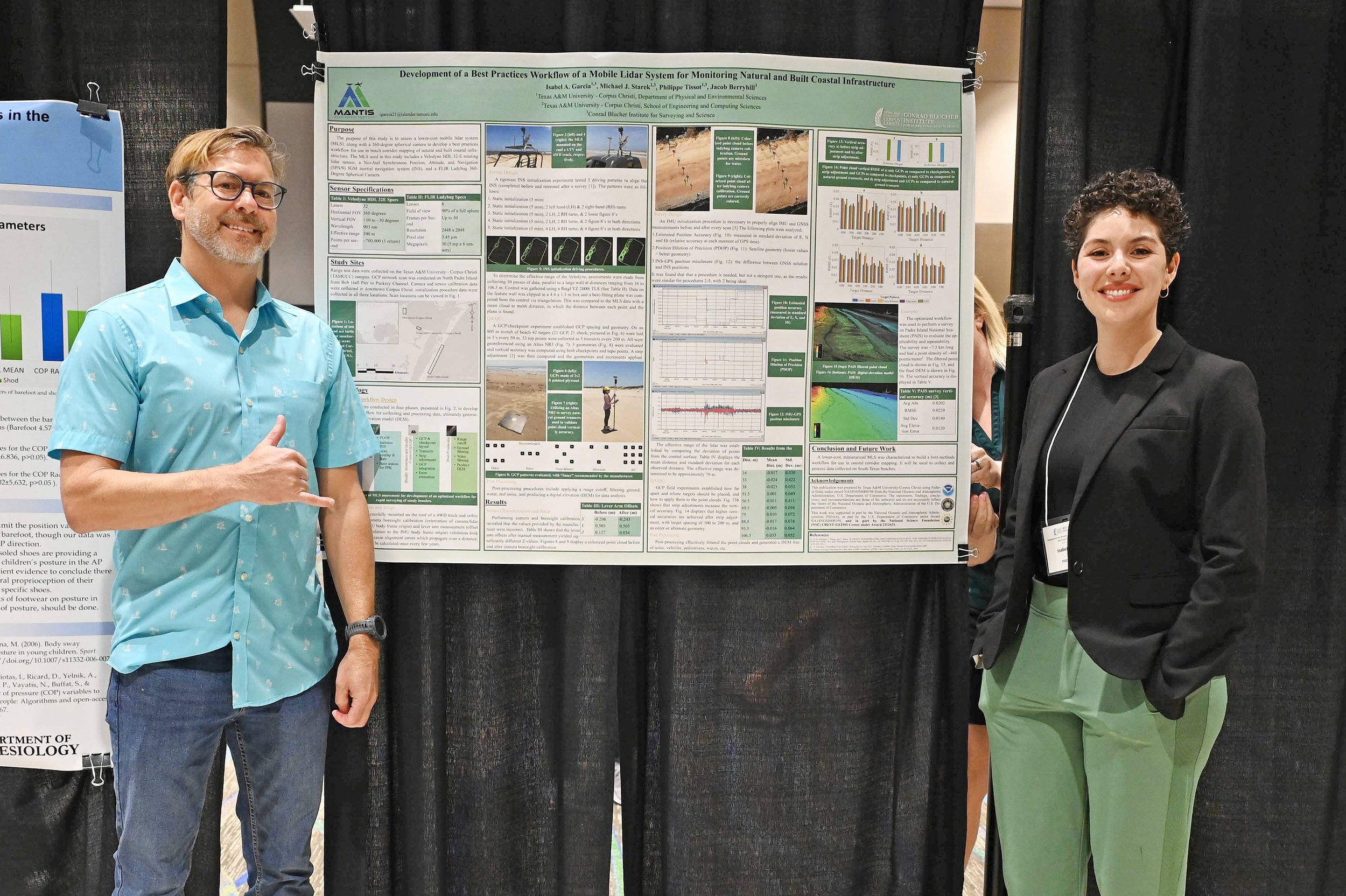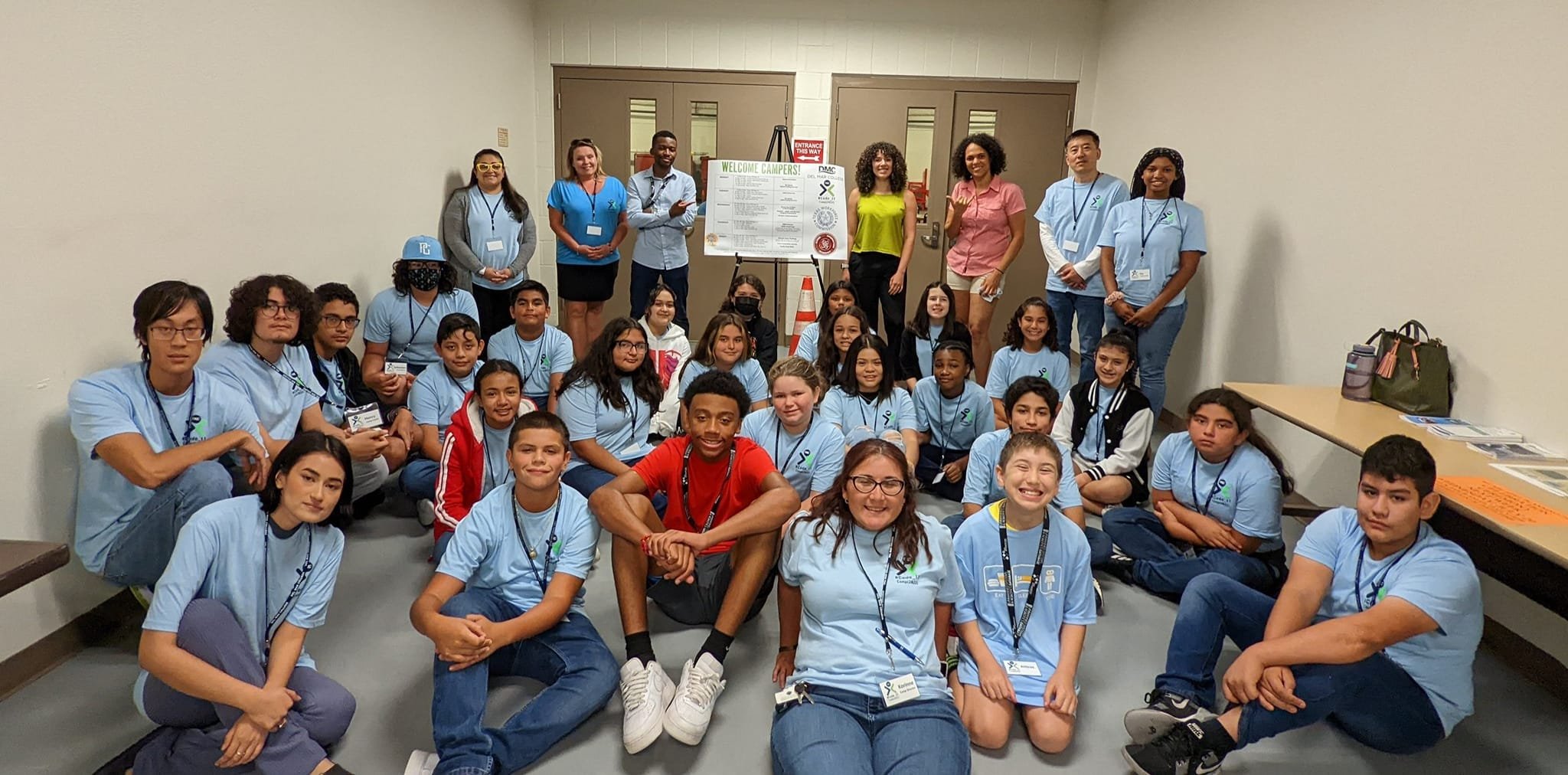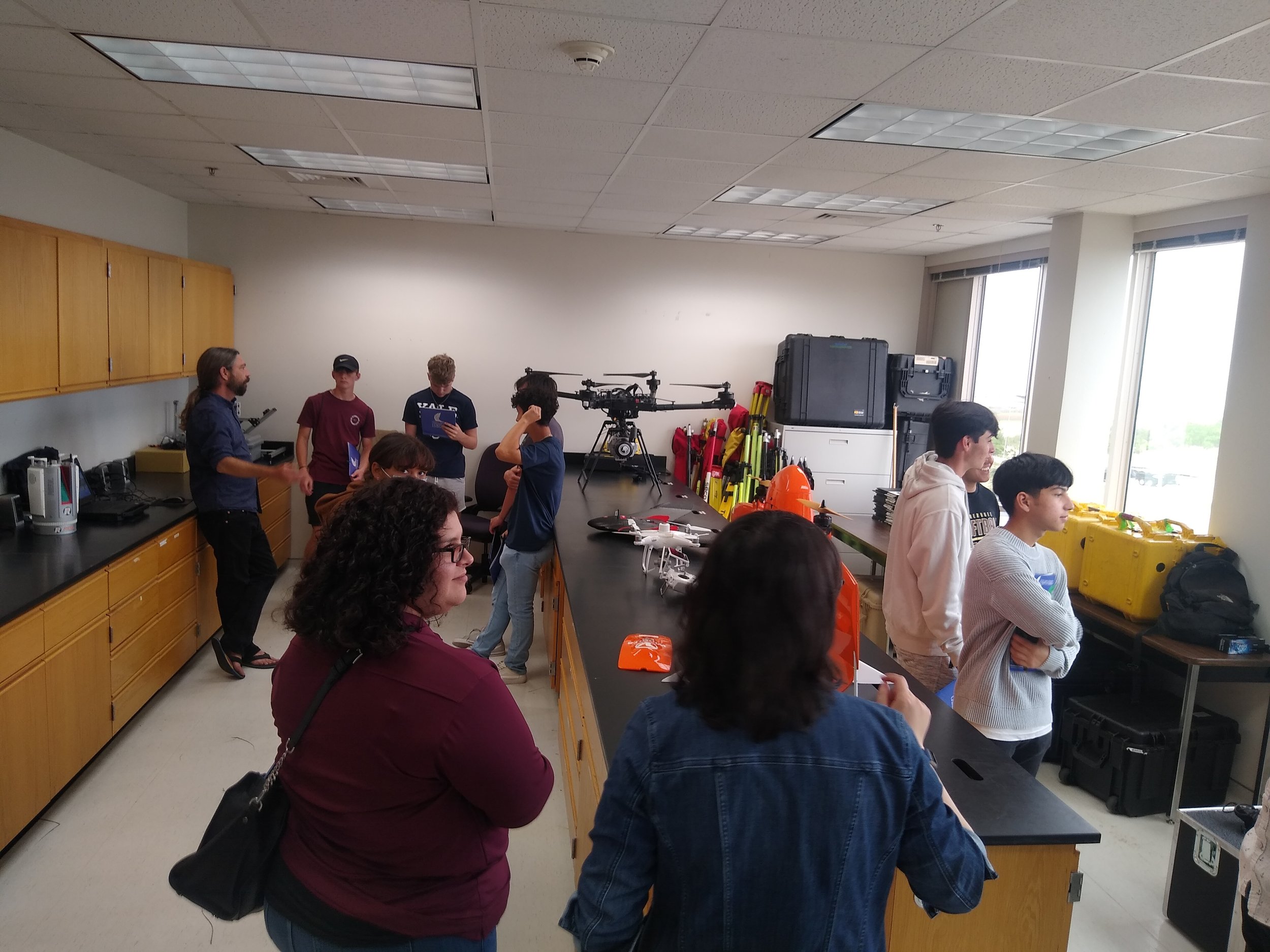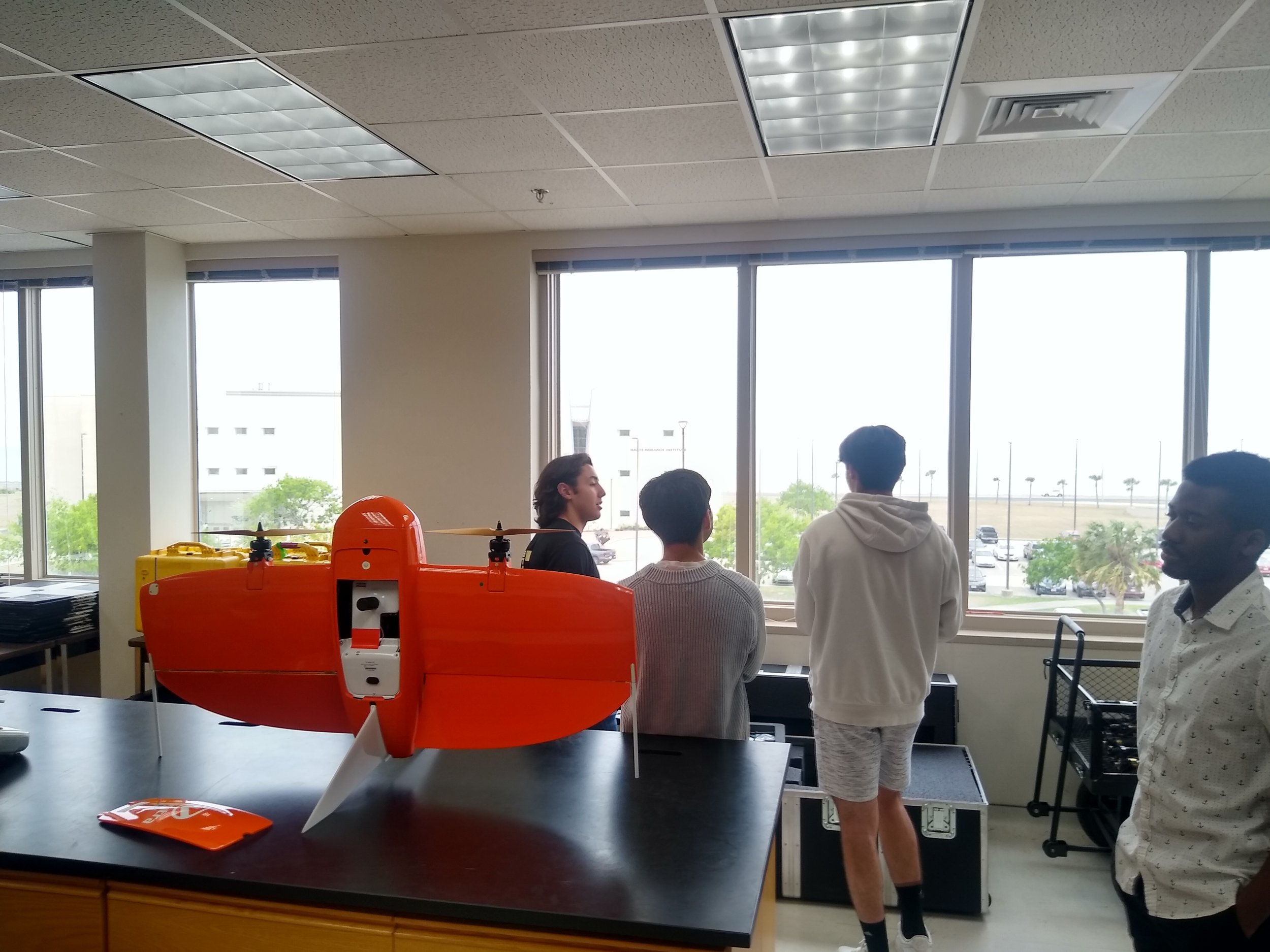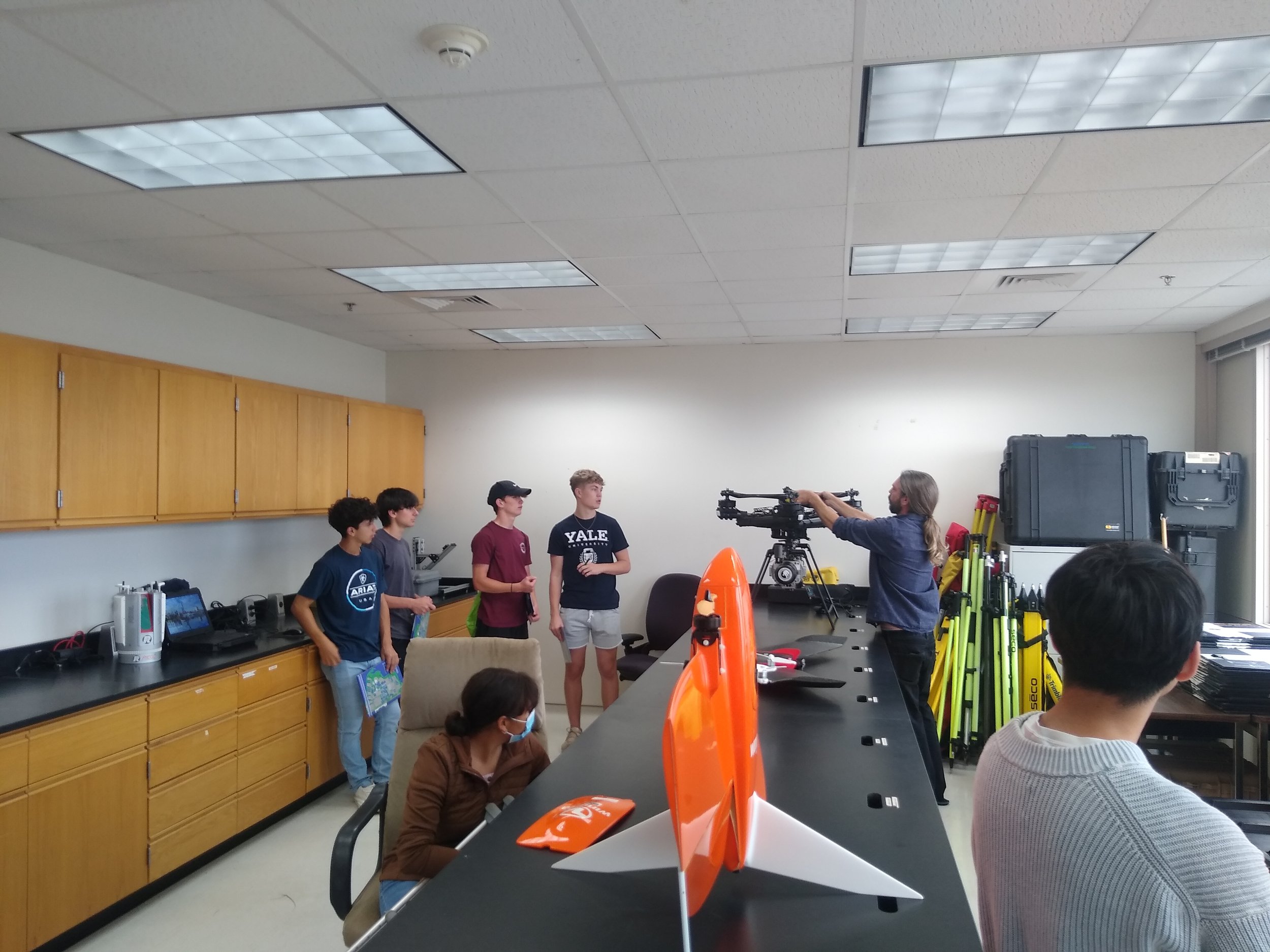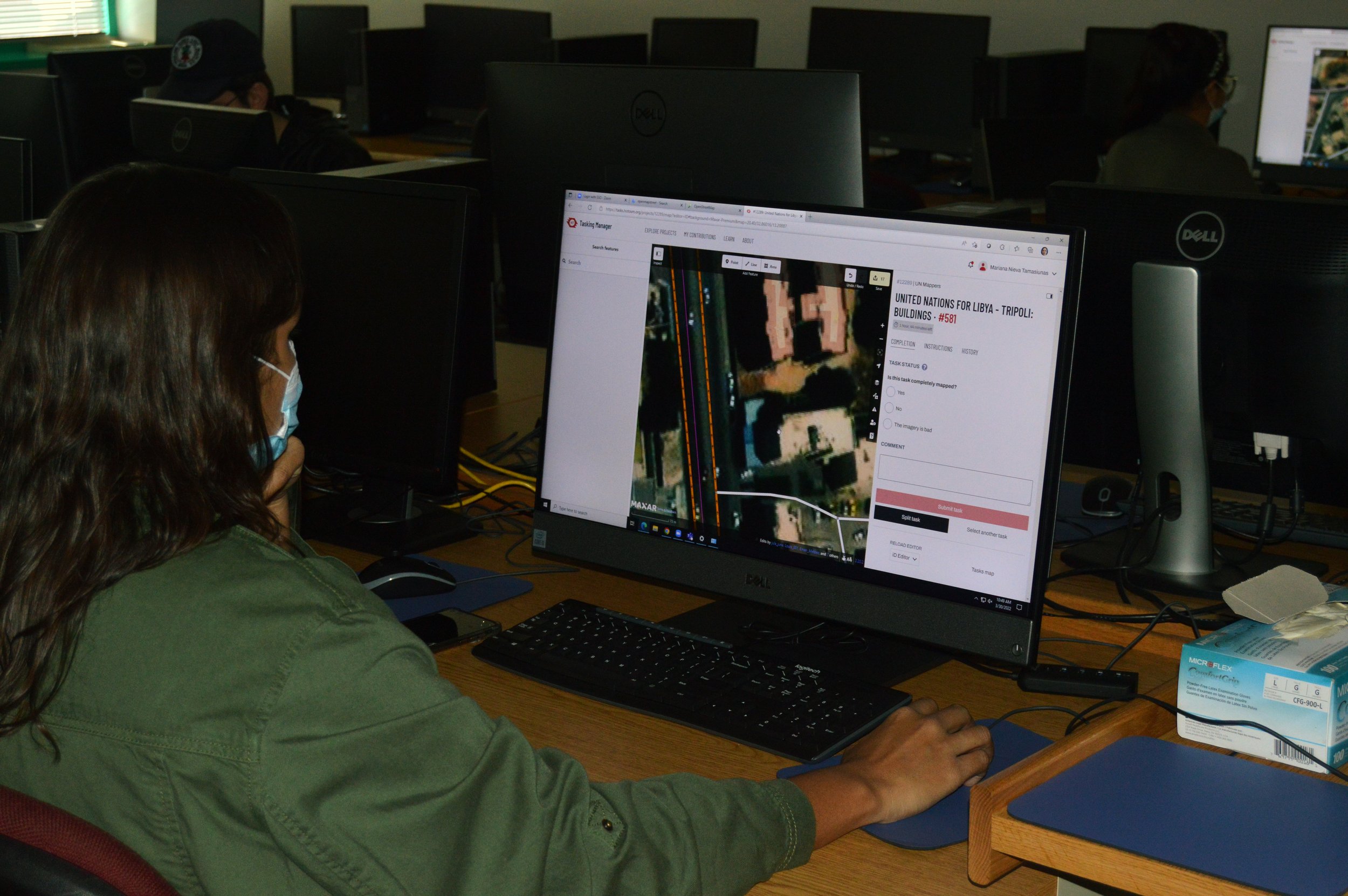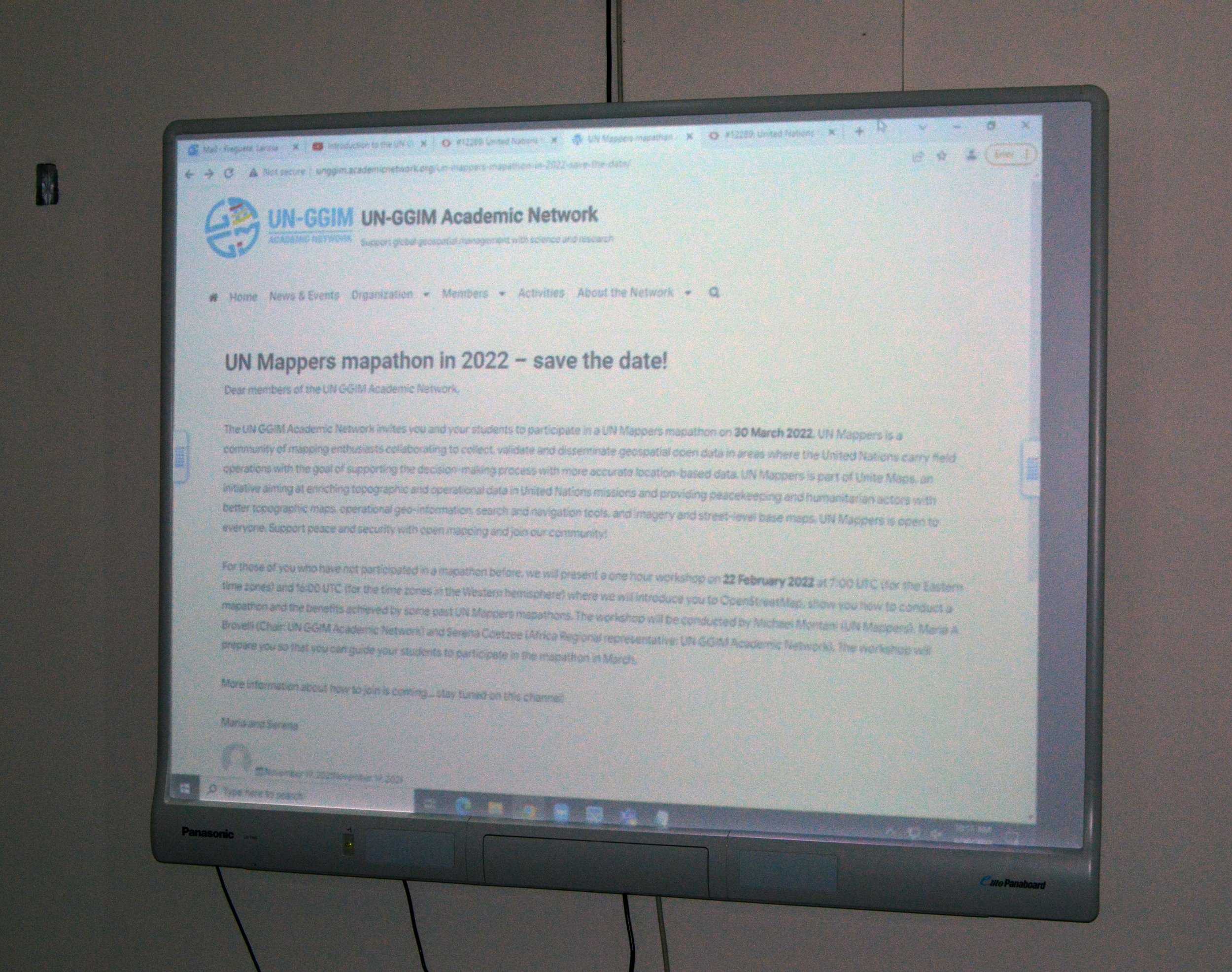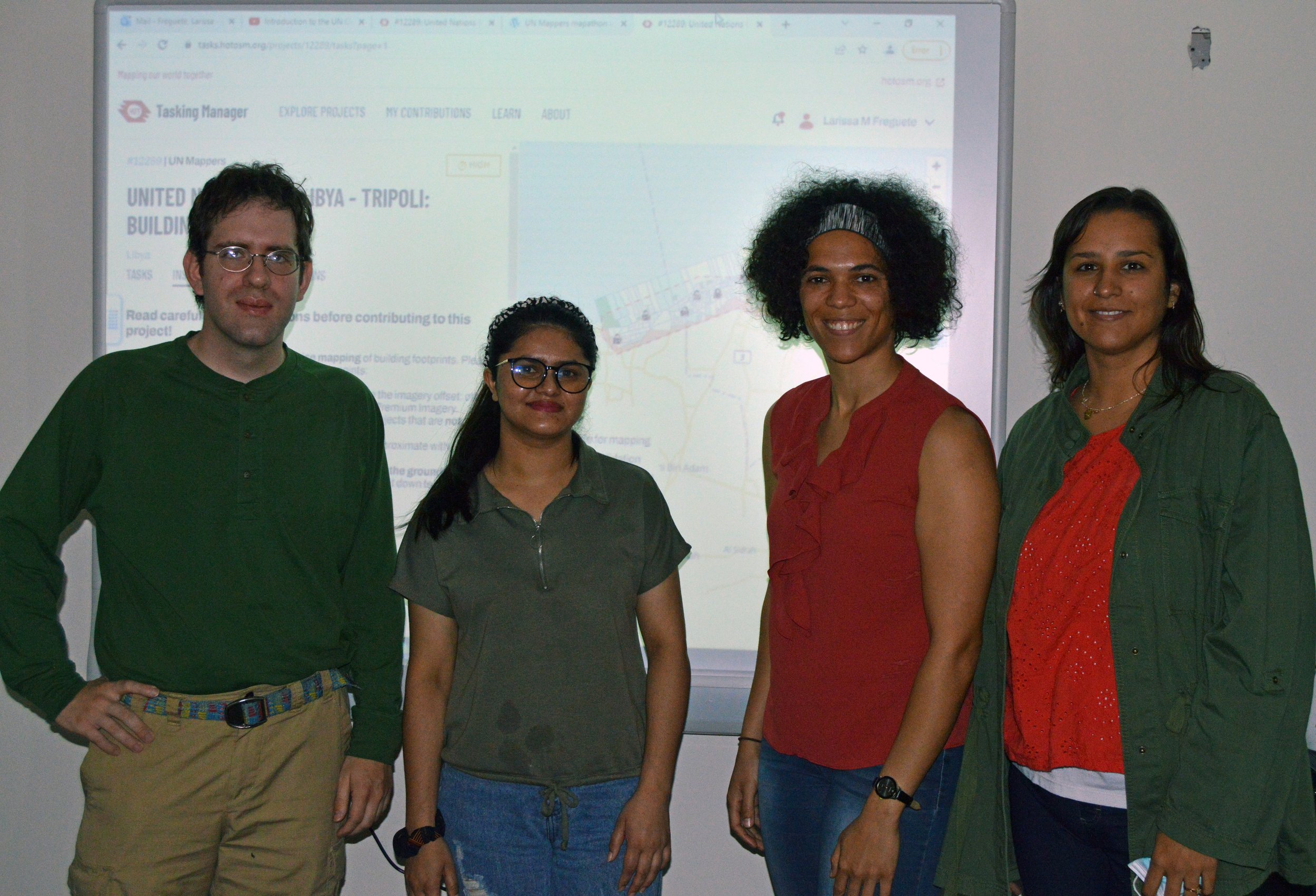The Measurement Analytics Laboratory was recently featured in the Research & Innovation Annual Report (2023) of Texas A&M University-Corpus Christi. The feature, titled Integrating UAS Technology to Revolutionize Highway Construction, outlines the work MANTIS has been doing in collaboration with the Texas Department of Transportation (TxDOT) in integrating UAS-SfM and UAS-Lidar to support surveying applications.
José Pilartes-Congo Awarded TSPS Award
In a heartwarming ceremony held at the annual Texas Society of Professionals Surveyors (TSPS) Convention Awards Gala on October 6, 2023, José Pilartes-Congo, a dedicated student of MANTIS, was honored with the prestigious "Student Volunteer of the Year" award. The event celebrated individuals who have made significant contributions to the land surveying profession in the State of Texas. Receiving the "Student Volunteer of the Year" award was a humbling experience for Pilartes-Congo. In his acceptance speech, he emphasized the importance of teamwork and expressed gratitude to the GIS Student Organization and the Conrad Blucher Institute at Texas A&M University-Corpus Christi who, in his words, were instrumental in making this happen.
Representatives from Google Visit MANTIS
In an exciting recent development, representatives from Google were given a tour of MANTIS Laboratory's research and state-of-the-art technology. The talks between Google and MANTIS delved into the various applications of geosensing technologies, 3D imaging, and GeoAI that the on which the MANTIS team is currently working.

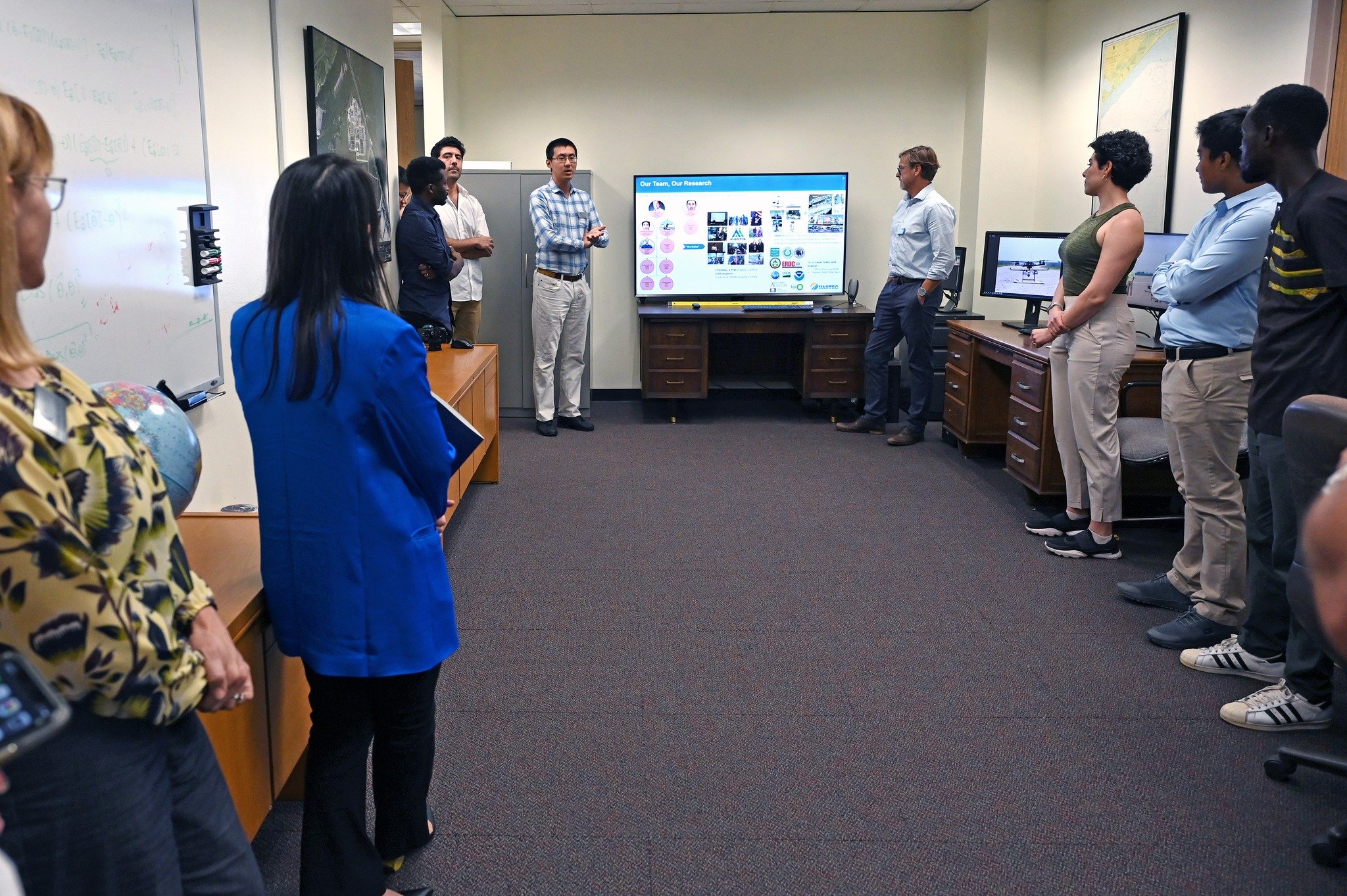




José Pilartes-Congo Featured by College of Engineering and Computer Science
MANTIS student José Pilartes-Congo was featured in the Engineering Newsletter Newsletter (September 2023) of the College of Engineering and Computer Science at Texas A&M University-Corpus Christi. The article highlights intel about José’s research, past accomplishments, and advice for upcoming students.
José Pilartes-Congo Featured in Texas Surveyor Magazine (September Edition)
MANTIS Ph.D. student José Pilartes-Congo was chosen as the Texas Society of Professional Surveyors (TSPS) featured member of the September edition of the Texas Surveyor Magazine. The feature outlined José’s recent research and responsibilities within the MANTIS Laboratory of the Conrad Blucher Institute.
Texas Surveyor Magazine Feature
MANTIS Well-Represented at IGARSS (Pasadena, California - 2023)
MANTIS Director, Dr. Michael Starek, post-doctoral fellow Dr. Mohammad Pashaei, and Ph.D. students Xiaojun Qiao and José Pilartes-Congo represented MANTIS at the 2023 International Geoscience and Remote Sensing Symposium (IGARSS) in Pasadena, California, between 16-21 July, 2023. The IGARSS conference, a globally recognized platform for Earth and geospatial science professionals, witnessed the participation of a record number of students this year. Their involvement underscored the rising interest and importance of remote sensing technology in addressing critical global challenges.
Presentations Titles:
Application of Semantic Image Segmentation for Efficient UAS-SfM Mapping
Coastal Subsidence Analysis Between Houston and Galveston, Texas, U.S.A.
Impact of Different GNSS Solutions on UAS-SfM Vertical Accuracy for Shoreline Mapping
Implementation of a ZED 2i Stereo Camera for High-Frequency Shoreline Change and Coastal Elevation Monitoring
As IGARSS 2023 drew to a close, it was evident that MANTIS’ research would continue to advance the frontiers of remote sensing and contribute to our understanding of Earth's complex systems.
Pratikshya Regmi and Jose Landivar Defend Master's Theses
Pratikshya Regmi and Jose Landivar conclude their master journey with two successful thesis defenses of their research over the past couple of years.
Pratikshya’s Abstract:
This research aims to utilize uncrewed aircraft system (UAS) photogrammetry and deep learning techniques to provide effective and user-friendly approaches for detecting palm trees, thereby facilitating monitoring and management initiatives. This study was carried out at Texas A & M University-Corpus Christi (TAMUCC) Ward Island campus. The primary purpose of this study was to utilize high-resolution orthomosaic imagery generated from UAS-based structure-from-motion (SfM) photogrammetry to detect, map, and quantify the number of palm trees on campus. A GIS-based pre-trained model and a customizable model were evaluated. The deep learning model exhibiting the highest performance in terms of precision, recall, and F1-Score was selected as the optimal model. The model obtained through fine-tuning of a pre-trained GIS-based model was identified as the optimal choice, yielding the following values: precision=0.88, recall=0.95, and F1-score=0.91. The chosen optimal model was employed to examine the impact of image ground sampling distance (GSD) on the deep learning model’s classification performance. GSD values were varied by downsampling of the original image GSD to values of 5 cm, 10 cm, 20 cm, and 40 cm, respectively. The findings revealed that the model’s performance deteriorated as the resolution decreased. Furthermore, the optimal model was subjected to an additional test using multi-temporal image datasets acquired from different UAS flights conducted at the same altitude with approximately the same GSD (1.6 cm). Remarkably, the results demonstrated that the model maintained a comparable level of accuracy across all three testing datasets. The obtained results were verified using ground truth values of palm tree counts taken from a portion of the campus study area. This study concludes that fine-tuning a pre-trained deep learning model within a GIS-based framework enabled a relatively high level of classification performance for the task of palm tree detection and mapping using UAS orthomosaic imagery. Although the effectiveness of the model decreased with reduced image GSD, the model was able to maintain relatively consistent performance across different UAS flights with imagery acquired at the same approximate GSD demonstrating it’s potential for generalization.
Jose’s Abstract:
In the rapidly evolving fields of geospatial engineering and precision agriculture, the accuracy and reliability of georeferencing techniques and Uncrewed Aircraft System (UAS) methodologies are crucial for effective decision-making and crop management. This research aims to enhance UAS Structure-from-Motion (SfM) photogrammetry data quality for plant height estimation in support of precision agriculture. The study investigates and compares the accuracy and reliability of three distinct methods used for georeferencing of the UAS imagery, which subsequently enables more accurate SfM 3D reconstruction: Global Navigation Satellite System (GNSS) without any correction aiding (GNSS-only), GNSS+Real-Time Kinematic (RTK), receiving RTK corrections from a local base station, GNSS+Real-Time Network (RTN), receiving RTK corrections from the Texas Department of Transportation (TxDOT) GNSS reference station network. The study further assesses the correlation between manually measured plant heights and those estimated from UAS-SfM point cloud data, exploring three different Digital Terrain Model (DTM) generation techniques. The research was conducted at the Texas A&M AgriLife Research and Extension Center in Corpus Christi, Texas, USA, on corn crops grown during the 2022 and 2023 agricultural seasons. The three DTM generation methods under consideration included 1) using a DTM acquired from a flight conducted before plant emergence, 2) creating a DTM by interpolating ground height points, and 3) implementing automatic classification algorithms. Our findings reveal that the GNSS+RTK solution implemented with a DJI D-RTK 2 mobile station acting as a local base for providing RTK corrections during flight provided the most reliable and accurate outcomes across multiple data collection dates for the UAS platform evaluated. Furthermore, the use of one ground control point (GCP) improved accuracy compared to scenarios with no GCPs used, while GNSS-only without correction aiding reported the least accurate results as expected. Regarding plant height estimation, the highest accuracy was generally achieved with greater canopy cover percentages, with the optimal percentage varying depending on the data collection date and DTM creation method. The highest correlation of 0.92 between manual measurements and UAS-SfM-derived plant heights was found when the DTM was either interpolated from ground height points or obtained from a pre-emergence flight.
Michael Starek Promoted to Professor
Dr. Michael J. Starek, director of MANTIS, was recently promoted to Professor of Geospatial Systems Engineering at Texas A&M University - Corpus Christi. This marks yet another great accomplishment in his portfolio, having recently been named Chair for Remote Sensing and Autonomous Systems for Geomatics for the Conrad Blucher Institute, and received a research and innovation excellence award all in the 2022-2023 academic year.
Pratikshya Regmi Presents at the International Federation of Surveyors Conference in Florida
Pratikshya Regmi, a second-year MANTIS master student in the Geospatial Systems Engineering program, presented her research at the International Federation of Surveyors (FIG) conference in Orlando FL, between May 28 and June 1, 2023.
Summary of Project/Presentation:
This project, referred to as Campus UAS, employed a small uncrewed aircraft system (UAS) platform equipped with RGB cameras for surveying and mapping campus infrastructure and facilities at Texas A&M University-Corpus Christi (TAMU-CC) since 2014. Pratikshya’s presentation began by highlighting the necessity of survey data and the benefits of implementing UAS for aerial surveys instead of using the traditional ground-based methods employed at the university. It then elaborated on the genesis of UAS platforms used at the university from 2014 to the present day including the evolution from indirect georeferencing using a ground control point network to more direct georeferencing alternatives using onboard global navigation satellite system (GNSS) receivers equipped with post-processed kinematic (PPK) capabilities/corrections. In addition, she discussed the benefits of integrating UAS products with traditional land surveying methods to obtain survey-grade accuracy from photogrammetric products derived from UAS. Lastly, attention was brought to diverse applications of UAS survey products beyond facility management and infrastructure planning and dissemination methods.
Overall, her work provided a comprehensive overview of the progression of UAS mapping technology for geospatial data acquisition in support of facilities monitoring at TAMU- CC.
Michael J. Starek Recognized at the 2023 Research and Innovation Excellence Awards
Dr. Michael J. Starek, director of MANTIS, was a recipient of an award at the 2023 Research and Innovation Awards ceremony hosted by Texas A&M University-Corpus Christi on April 14, 2023. This is a well-deserved award for Starek, who continues to lead innovative research in the geospatial engineering and remote sensing realms, in addition to mentoring several undergraduate and graduate students.
MANTIS Students Present at 2023 Student Symposium for Innovation Research & Creative Activities
Isabel Garcia, José Pilartes-Congo, and Pratiskhya Regmi presented at the 2023 Student Symposium for Innovation Research & Creative Activities (SSIRCA) held at Texas A&M University-Corpus Christi on April 21.
The annual symposium serves as a platform for supporting student research and creative work, helping students achieve their academic and career goals. Participation encourages students to showcase their research ideas, discoveries, and creative work and receive meaningful feedback from an evaluation panel of established TAMU-CC faculty members and researchers. Participation also prepares students for presentations at national and international events.
Larissa Marques Freguete Defends Master’s Thesis
One more to the MANTIS’ records! 2022 has been a year full of accomplishments for our lab: the master's student Larissa Marques Freguete has joined the list of MANTIS members who have successfully defended their research work this year. On November 15th, she publicly presented her master’s thesis titled Evaluation of UAS-based Photobathymetry Techniques for Coastal Shallow Water Mapping.
Larissa has been working with Remote Sensing with applications within the ocean realm since her bachelor studies and has dedicated herself to coastal bathymetry mapping subject after joining the MANTIS group as a master’s student. For her research topic, she accepted the challenge of tackling the issue of UAS-based photobathymetry techniques and has successfully accomplished it. To learn more about her thesis work, read the abstract below.
Abstract
Uncrewed Aircraft System (UAS)-based photobathymetry techniques are perceived as a solution for a more flexible, cost-effective, time-consistent, and spatially denser bathymetric mapping in shallow coastal waters. These are emerging techniques, implemented by small UAS equipped with digital cameras, and have only started to be explored, so questions about their application capabilities remain to be answered. This study aims to compare the three main UAS photobathymetry techniques (video-based linear depth inversion, optical inversion, structure-from-motion/multi-view stereo (SfM-MVS) photogrammetry) and UAS-based bathymetric light detection and ranging (lidar) regarding their operational advantages and limitations. The comparison was based on a literature review and on the performance assessment of two conceptually opposing UAS photobathymetry techniques: video-based linear depth inversion using the cBathy algorithm and SfM-MVS photogrammetry referred to as UAS-SfM. Flight experiments were conducted over a wave-dominated sandy beach on Mustang Island, TX, for the evaluation of linear depth inversion and over wave-protected bayside areas of St. George Island, FL, and Mustang Island, TX. The flights over bayside areas were set to evaluate the effect of camera orientation, solar elevation angle, and ground sample distance (GSD) on UAS-SfM performance. The cBathy algorithm provided a digital surface model (DSM) of the surf zone bathymetry with an overall root mean square error (RMSE) of 0.21 m. Performance of the UAS-SfM flight experiments varied by study site and flight design. The flight with a camera orientation of 30o off-nadir, orientated along the sun azimuth, at high solar elevation angle, and at an altitude of 100 m produced the most accurate bathymetric DSM with an RMSE of 0.15 m at the Florida study site. Based on the comparative field tests and literature review, the ultimate contribution of this work entails a set of guidelines and recommendations for the operational use of the various UAS-based photobathymetry techniques.
Xiaojun Qiao Defends Doctoral Proposal
On a sunny Friday afternoon of August 26, 2022, in a sinking Corpus Christi coast, one more MANTIS student has successfully defended a dissertation proposal.
Xiaojun has been working with Remote Sensing and applications for measurements with hyperspectral sensors since his master’s degree and has focused on the utilization of Interferometric Synthetic Aperture Radar (InSAR) for the estimation of land subsidence on the Texan coast as his Ph.D. research topic. His work has been developed under Dr. Chu’s supervision and it is titled Estimating Land Subsidence and Sea-Level Changes Combined with Geodetic Techniques along The Texas Gulf Coast, USA. To learn more, read his abstract below.
Abstract
Global sea-level data have long been recorded via tide gauge (TG) stations by measuring relative water-land movement, referred to as relative sea-level change (RSLC). RSLC is an aggregated effect of 1) vertical land motion (VLM) and 2) sea surface height changes relative to a defined geocentric reference frame, referred to as absolute sea-level change (ASLC). A consistently rising sea level can increase flood risks and cause remarkable impacts on ecosystem resilience, near-shore infrastructures, the daily lives of coastal residents, etc. Understanding the spatial and temporal patterns of VLM is deemed crucial for the knowledge discovery of RSLC. This research proposes to estimate VLM along the Texas Gulf Coast, one of the leading subsided areas in the United States, from multiple sources of observation data: 1) TG plus satellite radar altimetry (SRA); 2) the global navigation satellite system (GNSS); and 3) the interferometric synthetic aperture radar (InSAR). A high-resolution VLM map will be produced by exploring the spatiotemporal patterns of VLM results from different methods. In addition, the VLM results will be aggregated with the ASLC trend estimated using SRA data to project RSLC changes. Finally, based on the estimation results of VLM and RSLC, locations for installing new GNSS/TG stations will be recommended through geographic information system (GIS) and spatial analysis by considering various features, such as distribution of existing stations, spatiotemporal variability of VLM/RSLC, estimation uncertainty, and so forth. Results will hopefully provide knowledge to pertinent stakeholders to assist the decision-making process.
MANTIS Takes Part in Del Mar’s Code Summer Camp
This summer, the 4th edition of Del Mar's Code Camp unfolded from July 18th to July 22nd within the FEMA Dome at the Del Mar College Windward Campus. Del Mar's Code Camp is an integral component of the college's Youth Program, designed to keep young minds active and engaged during the summer months while fostering their continued education. This particular camp serves as an inspirational initiative aimed at motivating middle school students, to explore STEM disciplines, particularly the realm of computer science.
Throughout the span of a week, participants were immersed in the fundamentals of programming logic and code scripting. They also had the chance to put their newfound knowledge to practical use by constructing and programming robots and drones.
And speaking of drones, MANTIS Lab was naturally a part of the action! During the latter part of the event, MANTIS Lab students, in collaboration with other researchers affiliated with the AI2ES NSF Institute, joined forces with the young participants. MANTIS students had the unique opportunity to introduce these bright minds to the diverse applications of unmanned aircraft systems (UASs) and Lidar-based data. They delved into various sensor types and platforms, providing insights into the groundbreaking work undertaken by the group.
This marked the second occasion where MANTIS Lab participated in such an event, and the experience was gratifying. The genuine enthusiasm witnessed in these young minds within the field was particularly rewarding.
Looking ahead, MANTIS Lab is eager to continue contributing to future editions of the Code Camp, with the goal of inspiring and nurturing the potential of many more young minds in the world of STEM.
MANTIS’S Director Appointed CBI Chair for Remote Sensing and Autonomous Systems for Geomatics
We are pleased to announce the appointment of Dr. Michael Starek to the position of CBI Chair for Remote Sensing and Autonomous Systems for Geomatics. The appointment news took place on June 24, 2022, during the first CBI Town Hall for the year, as the Institute’s Director Dr. Smith presented the upcoming changes in the organizational structure and new steps for its future.
To put it shortly, to be a CBI Chair means to be a scientific leader for the institute. The position is an honorary appointment that acknowledges and recognizes academic achievement and provides a valuable tool to recruit and retain excellent faculty. To be nominated for this position, the individual must present a high level of performance and recognition of that performance within their field. Moreover, the position holders are appointed to the CBI Scientific Leadership Team which interfaces with the CBI Advisory Board as well as advises the CBI Executive team.
Dr. Starek has been a passionate docent and a very active and prolific researcher holding multiple titles as Program Coordinator of TAMUCC’s Geospatial Computer Science Ph.D. program, Associate Professor in the Geospatial Systems Engineering M.Sc. program, MANTIS’s Director, besides other roles. And now, he will have meritely added the CBI Chair title to this list.
“Dr. Starek embodies what a CBI Chair should be which is why he was selected as one of the inaugural Chairs. Mike is a true scientist and is well respected on and off campus through his research and publications. We are thrilled to have Mike lead us into the future in the Remote Sensing and Autonomous Systems for Geomatics area of research.”
CBI Director, Dr. Smith
Congratulations, Professor!
José Pilartes-Congo Defends Master’s Thesis
This past Friday, April 22nd, 2022, one more of MANTIS members, Jose Pilartes-Congo, has successfully defended his master’s thesis: Evaluation of Different GNSS Solutions and SfM Software Workflows for UAS Surveying of Shorelines.
José became part of the MANTIS family as an undergraduate student and stayed for his master’s degree. During his time as a master’s student, he focused on studying the impact of different methods for direct georeferencing of UAS-based imagery and the vertical accuracy performance of different SfM-MVS photogrammetry software. He has successfully accomplished his thesis work and has the intention of extending his research toward a Ph.D. dissertation.
MANTIS Lab congratulates our newest M.Sc. holder student and looks forward to seeing his next work. To learn more about his thesis work, read the abstract below.
Abstract
The emergence and modernization of Unoccupied Aircraft Systems (UAS), commonly known as drones, and Structure-from-Motion (SfM) photogrammetry have made significant contributions to the geospatial and surveying world. Traditionally, indirect georeferencing by using ground control points (GCPs) is used to georeference UAS imagery when high-accuracy positioning is required. However, this approach is tedious and impractical when surveying remote or inaccessible coastal areas, or when desiring to map coastlines from shipborne UAS operations. The broad applicability of UAS and SfM technologies has led to a wide range of data collection and SfM processing workflows that can be utilized, enhanced further by the implementation of various Global Navigation Satellite Systems (GNSS) techniques for direct georeferencing of the imagery. As part of an investigation conducted by the Office of Coast Survey (OCS) at the National Oceanic and Atmospheric Administration (NOAA), this study seeks to identify UAS-SfM data collection and processing workflows that maintain vertical accuracies at the decimeter level without the aiding of GCPs. The study uses UAS imagery collected from two different UAS platforms at two different sandy beach study sites along the southern Texas Gulf Coast. The objectives of the study are two-fold: (i) examine the applicability of Real-Time Kinematic (RTK), Post-Processed Kinematic (PPK), and Precise Point Positioning (PPP) GNSS solutions as plausible substitutes to ground control points (GCPs) for UAS-SfM shoreline mapping, and (ii) to evaluate the impact of three-commercial SfM software (Drone2Map, Metashape, and Pix4D) and one open-source software (Web OpenDroneMap) on the quantitative accuracy and qualitative appearance of resulting mapping products. Results showed that RTK and PPK can reach centimeter-level vertical accuracies, thus making them the most suitable alternatives to GCPs for remote surveying when plausible. When using PPK, the highest accuracies were reached when using base stations within 30 kilometers of the survey site, especially when combined with higher percentages of PPK fix, a measure that explains the number of photos that successfully underwent PPK correction. PPP offers the best alternative for remote UAS surveying, given that it is a single-receiver method, but the results evaluated here did not meet desired vertical accuracy levels. When comparing SfM software, Metashape and Pix4D proved to be the most robust software alternatives achieving repeatable centimeter-level vertical accuracies for derived mapping products.
TMISD High School Students Visit MANTIS
Last Wednesday, April 13th, MANTIS had the pleasure of being visited by the high school students from Tuloso Midway Independent School District (TMISD). The students are the beneficiaries of the TMISD regional CTE program of study focused on Geospatial Engineering and Land Surveying which has the purpose of preparing high school students for their academic development and providing the necessary skills required by the job market in this field.
As a way of showing the students the possibilities for their academic and professional development, they were offered a visit to the TAMUCC campus where they were introduced to the GISC program by Dr. Hongzhi Song, land surveying techniques by Dr. Davey Edwards, and the work developed by the MANTIS Lab.
For the MANTIS Lab tour, the students were first taken to MANTIS’ main premise where they were shown the variety of products generated by 3D mapping with lidar scanning and UAS-based imagery. They were also introduced to backpack lidar and to the concepts of 3D mapping, SfM photogrammetry, point clouds, etc. The sign of excitement was very visible on the student’s faces when they experienced 3D visualization of point clouds derived from different platforms.
The second part of the tour was a showcase of the equipment used for the research projects within the group: thermal cameras, TLS, surveying equipment, and different types and models of UAS platforms. In this part of the tour, they were presented they were introduced to the equipment and their applications and were encouraged to “play” with the thermal camera and to explore (with the proper safety measurements) the displayed surveying platforms.
The tour was topped off with the students having the hands-on experience of flying an indoor safe toy drone model.
Our wish is to see more and more young fellows entering the geospatial field, doing great deeds, and being well accomplished.
TAMUCC Students Participation in the UN GGIM MAPATHON 2022
On this past Wednesday, March 30th, TAMUCC students participated for the first time in the UN Mapper Mapathon event organized by the UN GGIM Academic Network. Mapathon is a once-in-a-year event where people all around the world get connected to voluntarily help mapping areas covered by UN missions to provide trustworthy information to the peacekeeping and humanitarian actors.
This year, the mapping project was focused on the African country Lybia. The participants were given the UNITED NATIONS FOR LYBIA-TRIPOLI project to work on, in which they had to map building footprints to support peacekeeping in the country. The information provided by the mappers will be used by peacekeepers in the region to assess inaccessible locations on the ground and perform operational planning.
According to the students’ feedback, participating in this event was a great experience because - besides the humanitarian purpose of the project - the used platform is very user-friendly and it does not require previous knowledge in the GIS field to be able to contribute, which offered a non-taxing experience to the users. The Mapathon session held in TAMUCC was attended by students from different programs (CMSS Ph.D., GSCS Ph.D., and GSEN MS) and MANTIS could not be left out of it: the lab participation was represented by the students Jose Congo, Pratikshya Regmi, and Larissa Marques Freguete as session mentor.
Fun fact: More than 13.000 buildings were mapped in this event!
One More Successful Participation of MANTIS Students at ASPRS 2022 Annual Conference
Click on the image to enlarge it
MANTIS Lab has a history of supporting the students’ professional and academic development by encouraging them to participate in workshops, conferences, and publishing their work. The consistent participation of MANTIS members in ASPRS annual conferences is a prove of it.
This year, the ASPRS 2022 Annual Conference was divided into two parts: a face-to-face conference format during Geo Week 2022 which occurred in Denver, CO, from February 6th to 8th, and an online Virtual Technical program that will take place in March. MANTIS Lab had its participation at the in-person conference represented by the members Dr. Mohammad Pashaei (Post-Doc fellow), Isabel Garcia (Ph.D. CMSS student), and José Pilartes-Congo (MS GSEN student). And one more time, the members had a successful participation by presenting their works during the oral and poster presentation sessions.
Below are the work titles presented by the attendees:
Dr. Pashaei: Full-Waveform TLS Point Cloud Classification Based on Samples of Digitized Echo Waveform (oral session).
Isabel Garcia: Development of a Best Practices Workflow for Monitoring Natural and Built Coastal Infrastructure with a Mobile Lidar System (poster session).
José Pilartes-Congo: Evaluation of Different GNSS Solutions on UAS-SfM Accuracy for Shoreline Surveying (poster session).
Good work, MANTISees!
431 Exchange Scholarship Awarded to MANTIS student, José Pilartes-Congo!
GSEN M.S. student and MANTIS Research Assistant José Pilartes-Congo is certainly having a good beginning of the year: he has just been awarded a 431 Exchange Scholarship.
431 Exchange is a nonprofit organization with a mission of helping people from different races, gender, or socio-economic backgrounds to succeed in their academic life. The purpose of this scholarship is to assist not only in the students’ academic performance but also in their social and extra-academic activities.














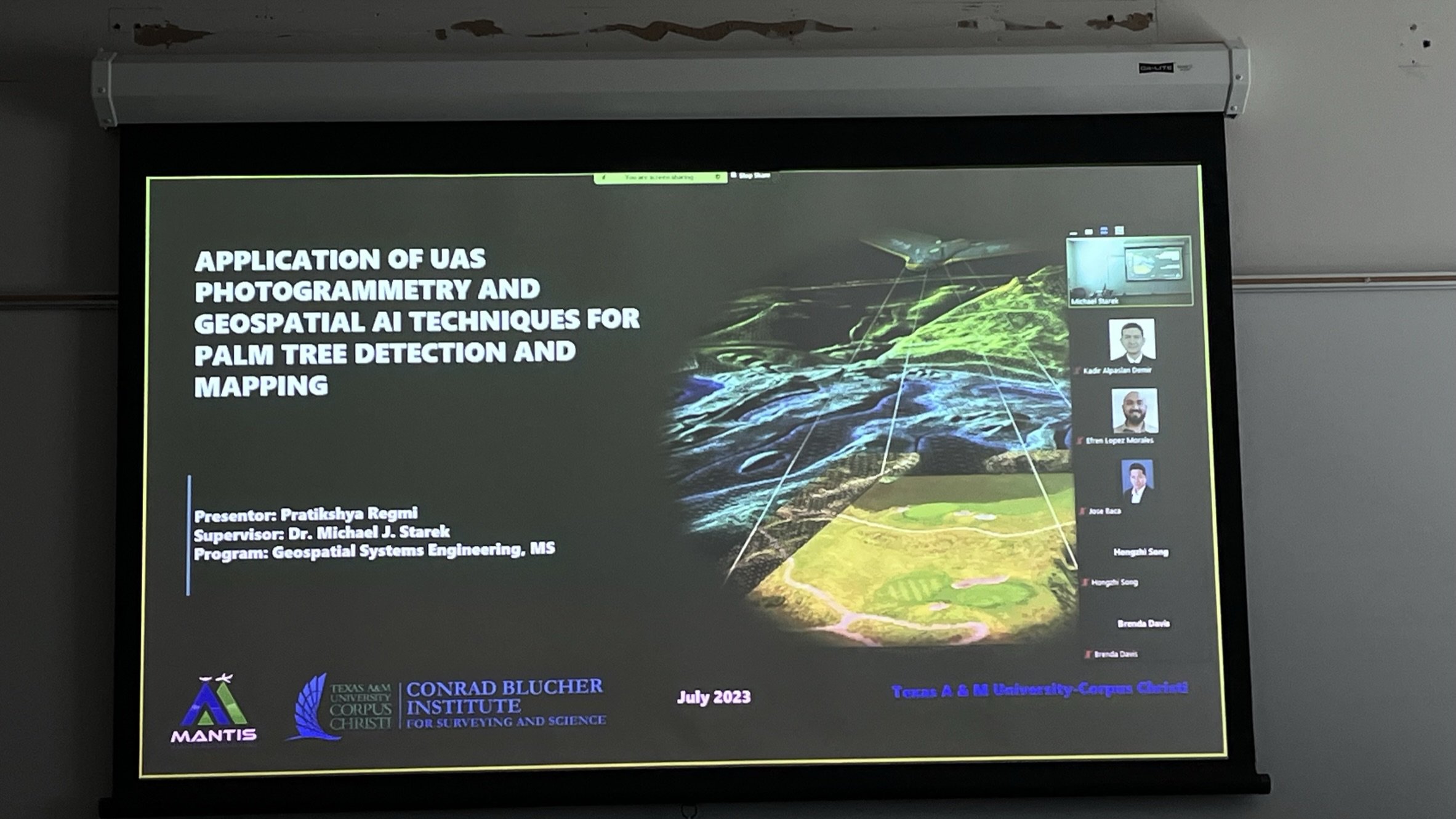





![Image[5].jpeg](https://images.squarespace-cdn.com/content/v1/5bd8bdcde17ba321ce9041f5/1685993326336-7ZJYHDKVWMIN7V7TZ2CC/Image%5B5%5D.jpeg)
![Image[6].jpeg](https://images.squarespace-cdn.com/content/v1/5bd8bdcde17ba321ce9041f5/1685993332708-5FT19GHIWG9P64E6B3PX/Image%5B6%5D.jpeg)
![Image[7].jpeg](https://images.squarespace-cdn.com/content/v1/5bd8bdcde17ba321ce9041f5/1685993335403-7X3OCRA5F49GOLZ3G430/Image%5B7%5D.jpeg)

